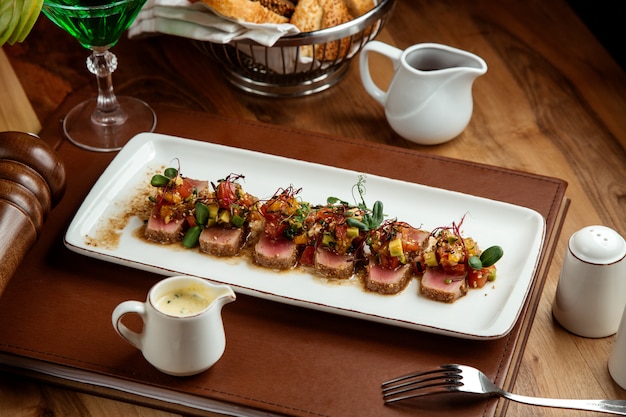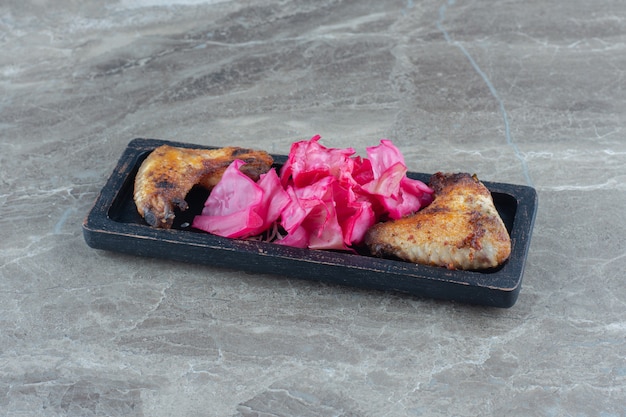Let's talk about filet mignon wrapped in bacon – a culinary masterpiece, a symphony of textures and flavors that's guaranteed to impress. It's the ultimate indulgence, a juicy, tender steak coated in crispy, smoky bacon. But, getting it right can seem daunting, especially for those who haven't quite mastered the art of the perfect steak.
Fear not, my friends, because I'm here to guide you through the entire process, from selecting the right cuts to mastering the perfect sear. I'll share my personal tips and tricks, gleaned from years of grilling, roasting, and generally making a bit of a mess in the kitchen. Let's dive in!
(Part 1) choosing the right cuts: The Foundation of Flavor

Finding the Perfect Filet: A Connoisseur's Choice
First things first, you need a decent piece of filet mignon. Now, I'm not talking about just any old cut of beef – we're aiming for the good stuff, the centre cut, the most tender and flavorful part of the tenderloin. Look for "centre cut filet mignon" or "filet mignon medallions" at your butcher's shop.
The center cut is the absolute star of the show – it's the most tender, flavorful, and consistent part of the tenderloin. It's what you want for a melt-in-your-mouth experience. You might be tempted by the "tail" or "tip" of the tenderloin, but these cuts are leaner and can be a bit tougher. Trust me, the center cut is worth the extra few quid.
Size Matters (But Not Too Much!): Getting the Proportions Right
The size of your filet is important, but it shouldn't be a major stress factor. For a single serving, I usually look for a filet that's about 1.5-2 inches thick and 4-6 inches long. You can go bigger for a crowd, but remember that the bigger the filet, the longer it'll take to cook.
A good rule of thumb is to allow about 1/2 inch of thickness per person. So, for two people, you'd want a filet that's at least 1 inch thick. You can always ask your butcher for advice on the perfect size for your needs.
Don't Forget the Bacon: The Crispy Compliment
Now, about the bacon. You can use any kind of bacon you fancy, but I'm a big fan of thick-cut bacon. It's got more flavour and holds its shape better during cooking. You'll need about 10-12 slices for a 1.5-2 inch thick filet mignon, depending on how much you like bacon (and let's be honest, who doesn't love bacon?).
Thick-cut bacon has a richer, more intense flavour and the fat content renders beautifully during cooking, giving you that irresistible crispy texture. It also wraps around the filet more securely, preventing it from falling apart during cooking. Don't be afraid to splurge on good quality bacon – it will make a world of difference in the final dish.
(Part 2) Prepping the Filet and Bacon: A Symphony of Textures

Trim and Season the Filet: Achieving Flavor Perfection
Once you've got your filet, it's time to trim it and season it. Now, I know what you're thinking: "Isn't it already trimmed?" Well, sometimes it is, sometimes it isn't. So, just give it a quick look and trim off any excess fat or silver skin. This will help the filet cook evenly and prevent it from being chewy.
Trimming off excess fat and silver skin will ensure even cooking and prevent the filet from tasting gamey. A quick tip: use a sharp knife and trim the fat and silver skin as close to the meat as possible.
Then, season the filet generously with salt and pepper. I like to use freshly ground black pepper, but you can use whatever you prefer. You can also add other spices like garlic powder or onion powder, but don't go overboard – remember, the bacon is going to add a lot of flavour too.
Salt is essential for drawing out the moisture and flavor of the meat, so don't be shy! Season generously and rub the salt evenly over the entire surface of the filet. The pepper adds a bit of warmth and complexity, but feel free to experiment with other spices like paprika, cayenne, or even a pinch of chili flakes.
Prepping the Bacon: Getting the Perfect Crunch
Now, onto the bacon. If you're using thick-cut bacon, you'll want to cut each slice in half lengthwise. This will make it easier to wrap around the filet and it'll cook more evenly.
This is an essential step for ensuring a perfectly crispy bacon wrap. Cutting the bacon in half also helps to create a more uniform layer around the filet, ensuring even cooking.
(Part 3) Wrapping the Filet: An Artistic Touch

Get Your Wrap On: Mastering the Technique
Here comes the fun part – wrapping the bacon! This is where your artistic skills come in handy, but honestly, even if you're not the most artistic person, you can still make it look good. I like to start by overlapping a couple of bacon slices lengthwise along the bottom of the filet. Then, I continue wrapping the bacon around the filet, overlapping the slices as I go.
Think of it like weaving a tapestry – each slice of bacon should overlap the previous one, creating a tight, even layer. The goal is to cover the entire surface of the filet with bacon, leaving no gaps.
Securing the Bacon: Keeping it Together
Once the filet is completely wrapped in bacon, you'll need to secure it. You can do this with toothpicks or kitchen twine. Toothpicks are easy to use and they do the job just fine. Just make sure to insert them at an angle to avoid poking holes in the filet.
Kitchen twine provides a more professional look and keeps the bacon tightly wrapped around the filet. Tie it securely at regular intervals to ensure the bacon doesn't come loose during cooking.
(Part 4) Cooking the Filet: Unleashing the Flavors
The Grill Method: Smoky Goodness
For the ultimate smoky flavor, I recommend grilling the filet mignon wrapped in bacon. Preheat your grill to medium-high heat and oil the grates. Then, place the filet on the grill and cook for about 5-7 minutes per side, or until the bacon is crispy and the filet is cooked to your desired level of doneness. Remember, the bacon will keep the filet moist, so don't worry about overcooking it.
Grilling imparts a smoky flavor to both the bacon and the filet, creating an irresistible taste combination. For even cooking, use a grill with consistent heat and ensure that the grates are clean and well-oiled to prevent sticking.
The oven method: Crispy and Convenient
If you're not a grill enthusiast or the weather isn't cooperating, you can always bake the filet in the oven. Preheat your oven to 400 degrees Fahrenheit (200 degrees Celsius) and place the filet on a baking sheet lined with parchment paper. Bake for about 25-30 minutes, or until the bacon is crispy and the filet is cooked to your desired level of doneness.
Baking is a reliable alternative for those who don't have access to a grill or prefer a more controlled cooking environment. The parchment paper prevents the filet from sticking to the baking sheet and makes cleaning up a breeze.
The Pan-Searing Method: A Quick and Easy Option
For a quick and easy method, you can pan-sear the filet in a cast iron skillet. Heat the skillet over medium-high heat and add a tablespoon of olive oil. Then, place the filet in the skillet and cook for about 3-4 minutes per side, or until the bacon is crispy and the filet is cooked to your desired level of doneness.
Pan-searing is the perfect method for a weeknight meal. It's quick, easy, and delivers a fantastic crispy crust on the bacon and a beautiful sear on the filet.
(Part 5) Resting and Serving: A Touch of Patience
Resting is Key: Allowing the Flavors to Develop
Once the filet is cooked, you need to let it rest for about 10 minutes before slicing. This will allow the juices to redistribute, resulting in a more tender and flavorful steak.
This step is essential for ensuring a juicy and flavorful steak. As the filet rests, the muscle fibers relax, allowing the juices to redistribute throughout the meat.
Slicing and Serving: The Final Touches
After resting, it's time to slice the filet and serve it up. I like to cut the filet into thick slices, about 1 inch thick. This makes it easier to eat and the bacon stays intact.
Thick slices are easier to handle and allow you to fully enjoy the interplay of flavors and textures – the juicy filet, the crispy bacon, and the delicious sauce.
(Part 6) Doneness Guide: Getting it Just Right
internal temperature is Key: Ensuring Perfect Doneness
Knowing how to determine doneness is crucial to getting your steak just right. Here's a handy guide to help you:
| Doneness | Internal Temperature (°F) | Internal Temperature (°C) |
|---|---|---|
| Rare | 125-130 | 52-54 |
| Medium-Rare | 130-135 | 54-57 |
| Medium | 140-145 | 60-63 |
| Medium-Well | 150-155 | 65-68 |
| Well-Done | 160 | 71 |
Using a meat thermometer: The Ultimate Tool for Accuracy
For accurate results, I always use a meat thermometer. Insert the thermometer into the thickest part of the filet (avoiding the bone if there is one).
A meat thermometer takes the guesswork out of cooking, ensuring that your steak is cooked to your exact preference. Make sure you invest in a good quality thermometer that's accurate and easy to use.
The Touch Test: A Quick Guide
If you don't have a meat thermometer, you can use the touch test. Gently press the centre of the filet. Here's how it works:
- Rare: The filet will feel very soft and will have a springy texture.
- Medium-Rare: The filet will feel slightly firm, like the flesh of your palm.
- Medium: The filet will feel firm and springy.
- Medium-Well: The filet will feel very firm, like the top of your thumb.
- Well-Done: The filet will feel very hard and rigid.
The touch test is a helpful guide, but it's less precise than using a thermometer. Practice it a few times to get a feel for the different levels of doneness.
(Part 7) side dishes and Sauces: Elevating the Experience
The Perfect Accompaniments: Creating a Culinary Ensemble
Now, let's talk about side dishes. Filet mignon wrapped in bacon is a versatile dish, so you can really get creative with your sides. My personal go-tos include:
- roasted asparagus: A light and healthy option that complements the rich flavors of the filet.
- mashed potatoes: The ultimate comfort food pairing.
- Creamed Spinach: A classic and delicious side dish that adds a touch of green to your plate.
- grilled corn on the Cob: A summery and fresh option that adds a sweet and smoky flavour to your meal.
These side dishes balance the richness of the filet mignon wrapped in bacon, offering a refreshing contrast in textures and flavours. Roasted asparagus brings a delicate crunch and a hint of bitterness, while mashed potatoes provide a creamy and comforting counterpoint. Creamed spinach adds a touch of earthy flavour and a touch of green, while grilled corn on the cob offers a sweet and smoky flavour that complements the bacon.
Sauces to Enhance the Flavour: The Finishing Touch
No filet mignon is complete without a sauce, and the good news is, there are endless possibilities. Here are some of my favourites:
- Béarnaise Sauce: A classic sauce that complements the richness of the filet.
- Red Wine Sauce: A robust sauce that adds depth of flavour to the dish.
- Mushroom Sauce: A rich and savory sauce that's perfect for steak lovers.
- Peppercorn Sauce: A spicy and flavorful sauce that adds a kick to the filet.
Sauces add a final layer of complexity and flavour to your filet mignon wrapped in bacon. Béarnaise sauce, with its tangy richness, is a classic pairing. Red wine sauce offers a robust and intense flavour, while mushroom sauce provides a rich and earthy taste. Peppercorn sauce adds a spicy kick that complements the smoky bacon.
(Part 8) Tips and Tricks: Achieving Mastery
Avoid Overcrowding the Pan or Grill: Ensuring Even Cooking
When cooking the filet, make sure to leave enough space between each piece. This will help the bacon cook evenly and prevent the filet from steaming.
Overcrowding the pan or grill can lead to uneven cooking and steaming instead of browning. Make sure there's enough space between each piece of filet for the heat to circulate and cook the bacon and the steak evenly.
Use a Baking Sheet: Protecting Your Grill
If you're grilling, you can use a baking sheet to catch any drips of fat. This will prevent the flames from flaring up and burning your bacon.
A baking sheet placed underneath the grill grate will catch the drippings and prevent flare-ups, which can damage your grill and give your bacon a burnt flavor.
Don't Forget the Rest!: Letting the Flavors Settle
As I mentioned before, resting the filet after cooking is crucial for ensuring tenderness and flavor.
The resting period is crucial for allowing the juices to redistribute throughout the meat, resulting in a more tender and flavorful steak.
Enjoy the Process: The Joy of Cooking
Most importantly, relax and enjoy the process. Cooking should be fun, and creating a delicious meal can be a very rewarding experience.
Remember, cooking is a journey, not a race. Take your time, experiment with different flavours and techniques, and most importantly, have fun!
FAQs
1. Can I use pre-cooked bacon?
You can use pre-cooked bacon, but it won't be as crispy as bacon cooked from scratch. You'll need to adjust your cooking time accordingly, as pre-cooked bacon will already be cooked through.
Pre-cooked bacon can be a convenient option, but it won't have the same crispy texture as bacon cooked from scratch. If you're using pre-cooked bacon, be sure to adjust your cooking time accordingly and make sure to cook it until it's heated through and slightly crispy.
2. What temperature should the oven be set to?
If you're baking the filet, I recommend preheating your oven to 400 degrees Fahrenheit (200 degrees Celsius). This will ensure that the bacon is crispy and the filet is cooked to your desired level of doneness.
The higher temperature ensures that the bacon gets crispy and the filet cooks quickly without becoming dry.
3. How can I tell if the filet is cooked to my liking?
Using a meat thermometer is the best way to determine the internal temperature of the filet. You can also use the touch test, but it's not as accurate as using a thermometer.
A meat thermometer is the most reliable way to ensure that your filet is cooked to your exact preference. The touch test can be a helpful guide, but it's not as precise.
4. What are some good side dishes for filet mignon wrapped in bacon?
Filet mignon wrapped in bacon is a versatile dish, so you can choose any side dishes you like. My personal favourites include roasted asparagus, mashed potatoes, creamed spinach, and grilled corn on the cob.
These side dishes provide a balance of flavours and textures that complement the richness of the filet mignon wrapped in bacon. Don't be afraid to experiment with different side dishes to create your perfect meal.
5. What are some good sauces for filet mignon wrapped in bacon?
You can really go all out with sauces for filet mignon wrapped in bacon. Some of my favourites include Béarnaise sauce, red wine sauce, mushroom sauce, and peppercorn sauce.
These sauces add a touch of elegance and complexity to the dish. Béarnaise sauce is a classic pairing, red wine sauce offers a robust flavour, mushroom sauce provides a rich and earthy taste, and peppercorn sauce adds a spicy kick.
Everyone is watching

Corn on the Cob: The Ultimate Guide to Perfectly Cooked Ears
Healthy MealsAh, corn on the cob. Just the name evokes images of sunny days, barbecues, and that sweet, juicy flavour that ...

Perfect Pork Roast Oven Cooking Time: A Guide to Delicious Results
Healthy MealsThere's something truly satisfying about a perfectly roasted pork. The aroma alone is enough to make your mout...

Ham Cooking Time: How Long to Bake, Smoke, or Boil a Delicious Ham
Healthy MealsAh, ham. It's a classic, isn't it? A real crowd-pleaser, especially around holidays. And when done right, it'...

Scallops: The Ultimate Guide to Perfect Cooking
Healthy MealsAh, scallops. Those delicate, sweet, and utterly delicious morsels of the sea. They hold a special place in my...

Spaghetti Squash: The Ultimate Guide to Cooking and Serving
Healthy MealsRemember that time you saw spaghetti squash at the supermarket, looking all bumpy and strange, and thought, "W...
